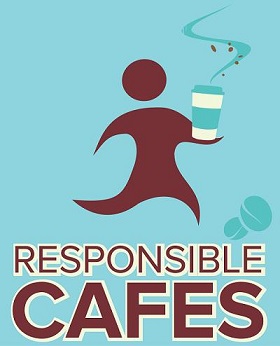
Sustainable Strathfield
Responsible Cafés
 Strathfield Council has partnered with Responsible Cafés to reduce the use of disposable coffee cups from our local cafés. Responsible Cafés is a not-for-profit organisation that featured on the ABC “War on Waste” TV series that focuses on the impact and solutions to material waste in Australia. Strathfield Council is one of almost 80 Councils to join the program and work with local businesses and the community to keep our environment healthy and clean.
Strathfield Council has partnered with Responsible Cafés to reduce the use of disposable coffee cups from our local cafés. Responsible Cafés is a not-for-profit organisation that featured on the ABC “War on Waste” TV series that focuses on the impact and solutions to material waste in Australia. Strathfield Council is one of almost 80 Councils to join the program and work with local businesses and the community to keep our environment healthy and clean.
The Problem
Over 3.6 billion disposable coffee cups and lids are used in Australia every year, almost none of which are recycled. This represents a major waste gap with a significant water, carbon, paper, petroleum and chemical footprint. A great majority of disposable cups and lids end up landfilled or littered and can take thousands of years to break down in the environment, contributing to land and marine pollution, and threatening wildlife.
The Solution
To address this problem, Strathfield Council is working closely with café owners and the community. The Responsible Cafés program encourages cafés to provide a small discount to customers who bring a reusable cup. Over the course of 15 coffees, a coffee drinker will have offset the environmental footprint of the reusable coffee cup*. Depending on the frequency of coffee consumed and the discount applied, consumers can very quickly make up the costs of their new reusable cup as well.
Since the program began, Council has engaged many café owners on responsible cafés and provided signage to participating businesses. Council continues to facilitate the program with ongoing discussion with our cafés and report on the impacts.
Responsible Cafes in the Strathfield LGA
Oliver Brown Strathfield
11 the Boulevard
The Smelly Cheese Cake
Strathfield
Cafe Crop
Strathfield
Gloria Jeans Strathfield
Strathfield
Rainbow Cakes
Strathfield
URBANO Organic Coffee Traders
Homebush
Homebush DFO Muffin Break
Sip Hour Coffee
Cafe De Vie
Homebush
Interlink Cafe
Tea Mates
Homebush West
Chef’s Palatte – Strathfield
Strathfield
Sydney Markets Plaza Cafe
Stra Pumpkin
Click here for a comprehensive map of Responsible Cafés in the Strathfield LGA.
This project is a NSW EPA Waste Less, Recycle More initiative funded from the waste levy.
* statistic taken from keepcup
Food Waste
Food waste is one of the largest waste categories and it can easily be diverted from landfill. Food waste makes up about half of all rubbish in Strathfield residential bins!
When food waste decomposes in landfill, it releases methane, a harmful greenhouse gas which has 20 to 100 times more global warming potential than carbon dioxide. In Australia, methane emissions from landfill make up about 3% of total greenhouse gas emissions, but have a much greater impact due to their global warming potential.
Avoid food waste! Check out “Love Food, Hate Waste” for tips on reducing food waste, and go to Compost Revolution for online tutorials on re-using food scraps. Plus make use of Council’s 50% discount for Strathfield residents!
If possible, think about growing fresh food for yourself, your family and friends. You can use the compost and fertiliser from recycling your food scraps to improve the quality of the soil in your garden.
Energy
Reducing the amount of energy you consume is not only good for your hip pocket it is beneficial for social and environmental reasons as well. Given that a large bulk of energy is produced from non renewable sources it is important to consider the resultant production of C02 and its contribution to the Enhanced Greenhouse Effect.
Most of councils energy usage and costs is from street lighting, which is being reduced due to the installation of energy efficient LED lighting.
There are many products on the market which have been specifically designed to minimise the amount of electricity they consume. Household appliances such as air conditioners, refrigerators and freezers, water heaters, washing machines and clothes dryers are all produced with energy efficient models. It is important to note when purchasing an appliance that some models are more efficient than others and that a labelling system exists in Australia to notify consumers how energy efficient the product is.
For more information regarding the Enhanced Greenhouse Effect and Energy Efficiency please visit:
- Energy Rating – advice on choosing an energy efficient applicance.
- Your Home – Government site with information and advice on home design.
- Australian Government Department of Climate Change and Energy Efficiency – a valuable resource including information on household and community energy efficiency, appliances, equipment, fittings and overall building efficiency.
- NSW Department of Environment Energy and Science website – a central source of information on the leading initiatives of the NSW Government in climate change and greenhouse related issues.
Water
Water Savings Tips
Water is one of our most precious resources and needs to be conserved. Water sensitive behaviour (using water wisely) from all of us will help sustain our natural environment and communities through times of drought, while building a community that is resilient to environmental shocks and stresses. Most of the water we are responsible for comes from the food we eat and the things we buy. All products, particularly food, have a significant (and sometimes hidden) water footprint. Energy generation and petroleum-based transport also use large amounts of water.
The biggest way to reduce your water use is by minimising your water footprint (less than 5% of our water footprint comes from normal household water use). For example, by switching to a vegan diet, you can save over 3,000 L of water per day.
Below are some of the best things you can do to reduce your water consumption, from most to least impactful:
- Choose plant based food over animal products (i.e. eat less meat, fewer dairy products and fewer eggs) and locally grown produce where possible
- Shop based on ‘needs’ not ‘wants’
- Share where possible
- Choose pre-loved or re-usable options where possible
- Minimise energy use and travel actively or on public transport
- Collect rainwater and greywater and use in the garden as well as for other non-potable uses
- Reduce water consumption at home and use water efficient appliances
Rainwater Tanks
Certain types of development require rainwater tanks to be installed to provide alternative water sources. Applicable developments are listed in section 2.1 of Part N of the Strathfield Council Consolidated DCP. The location of the rainwater tanks to be installed should be clearly indicated on plans and satisfy the requirements of Part A of the Strathfield Council Consolidated DCP.
Should owners of existing dwellings wish to install rainwater tanks within their properties development consent may be required. Some rainwater tanks may not need development consent. Please refer to Part A of the Strathfield Council Consolidated DCP for more information.
Installation of rainwater tanks on properties that are heritage items or contained in heritage conservation areas require Council approval. Please note that siting, size and locational requirements for rainwater tanks under State Environmental Planning Policy (Exempt and Complying Development Codes) 2008, override the provisions of the Strathfield Local Environment Plan and Strathfield Council Consolidated DCP Part A.
Why install rainwater tanks?
- Rainwater tanks reduce our reliance on drinking water. Lots of applications in the home don’t require drinking water quality standard
- Reduces the amount of water that runs off your property into the stormwater system which reduces pollution of waterways and flooding
- The collected rainwater can be used for watering gardens, washing cars, clothes and flushing toilets
Unfortunately NSW Health does not recommend drinking rainwater in the city
Do I need Council approval to install a rainwater tank?
- No, if the tank and its installation complies with State Environmental Planning Policy (Exempt and Complying Development Codes) 2008
- Yes, if the tank and installation doesn’t meet these exemptions eg heritage item or located in heritage conservation areas
How do I meet these requirements?
- Prefabricated tank designed to collect roofwater only
- Installed in accordance with manufacturer’s requirements and structurally sound
- Maximum capacity 10,000 litres
- Not located in front yard
- Fitted with first-flush device to reduce pollutants entering tank
- Fitted with screened inlet to prevent entry of debris or mosquitoes.
For additional requirements refer to State Environmental Planning Policy (Exempt and Complying Development Codes) .
Getting the most from a rainwater tank
- Tank capacity – As a rule of thumb a minimum tank size of 5,000 litres is desirable
- Use the rainwater on a regular basis so there is always storage capacity in the tank when it rains again eg connect to flush toilet, use in garden
Maintenance
- It is important to maintain your rainwater tank
- Rainwater tanks are low maintenance, not no maintenance
- Regularly clean your gutters, first flush device, and inspect screens of leaves and other debris
- Gutter guards can help

